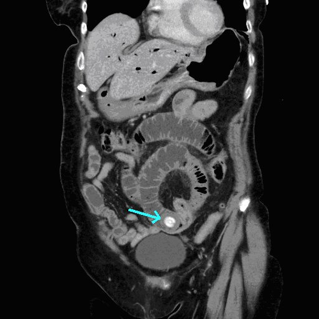Journals
Gallstone ileus: a seldom cause of mechanical bowel obstruction
Introduction
Gallstone ileus represents less than 0.1% of all mechanical bowel obstructions and is associated with high morbidity and mortality [1]. The condition occurs more frequent in females and elderly people [1]. Gallstone ileus is often caused by a fistula from the gallbladder to the small intestine [2]. Patients with gallstone ileus may present with a broad spectrum of abdominal symptoms, which can make it difficult to diagnose the condition, and this may cause delay in diagnosis and treatment [2]. A Computer Tomography (CT) scan is considered to be the best diagnostic imaging tool for gallstone ileus [3]. A CT-scan may show Rigler’s Triad, which consists of pneumobilia, mechanical bowel obstruction and an ectopic gallstone [3]. The recommended treatment for gallstone ileus is enterotomy with stone extraction [3].
We present a case of an 83-year-old woman who was admitted to the surgical department. She had previously been treated non-operatively for a stone in the common bile duct and cholecystitis.
She had suffered from abdominal pain, fever, nausea and vomiting for a 10-day period. Symptoms increased significantly prior to the hospitalization. A CT-scan of the abdomen was performed and showed mechanical obstruction in the small intestine caused by a gallstone (figure 1). The gallstone was 3 centimeters in diameter and was located in the jejunum. The image shows the gallstone (blue arrow) causing mechanical bowel obstruction with dilated small intestine orally and collapsed small intestine distally. Furthermore, air was seen in the intrahepatic bile ducts and gallbladder (pneumobilia).
The patient underwent surgery with enterotomy of the jejunum, and removal of the gallstone. The postoperative course was uncomplicated, and the patient was discharged after 8 days. She was doing completely fine at 1-year follow-up.
Figures

Figure legends
Fig. 1: 1: CT scan of the abdomen shows a gallstone (blue arrow) which causes obstruction of the small bowel.
Article Info
Article Type
Case ReportPublication history
Received 12 April, 2018Accepted 25 April, 2018
Published 6 May, 2018
Copyright
© 2018 Luit Penninga. This is an open-access article distributed under the terms of the Creative Commons Attribution License, which permits unrestricted use, distribution, and reproduction in any medium, provided the original author and source are credited. Hosting by Science Repository.10.31487/j.SCR.2018.10.009
Author Info
Corresponding author
Luit PenningaDepartment of Surgery and Transplantation C2122, Rigshospitalet, Copenhagen University Hospital, Blegdamsvej 9, Copenhagen DK-2100, Denmark
Figures & Tables

Figure legends
Fig. 1: 1: CT scan of the abdomen shows a gallstone (blue arrow) which causes obstruction of the small bowel.
References
1. Halabi WJ, Kang CY, Ketana N, Lafaro KJ, Nguyen VQ, et al. (2014) Surgery for gallstone ileus: a nationwide comparison of trends and outcomes. Ann Surg 259: 329-335. [Crossref]
2. Fitzgerald JE, Fitzgerald LA, Maxwell-Armstrong CA, Brooks AJ (2009) Recurrent gallstone ileus: time to change our surgery? J Dig Dis 10: 149-151. [Crossref]
3. Lassandro F, Gagliardi N, Scuderi M, Pinto A, Gatta G, et al. (2004) Gallstone ileus analysis of radiological findings in 27 patients. Eur J Radiol 50: 23-29. [Crossref]
